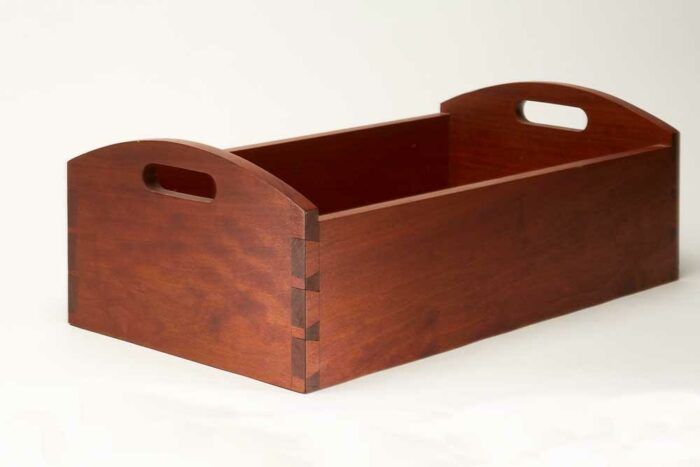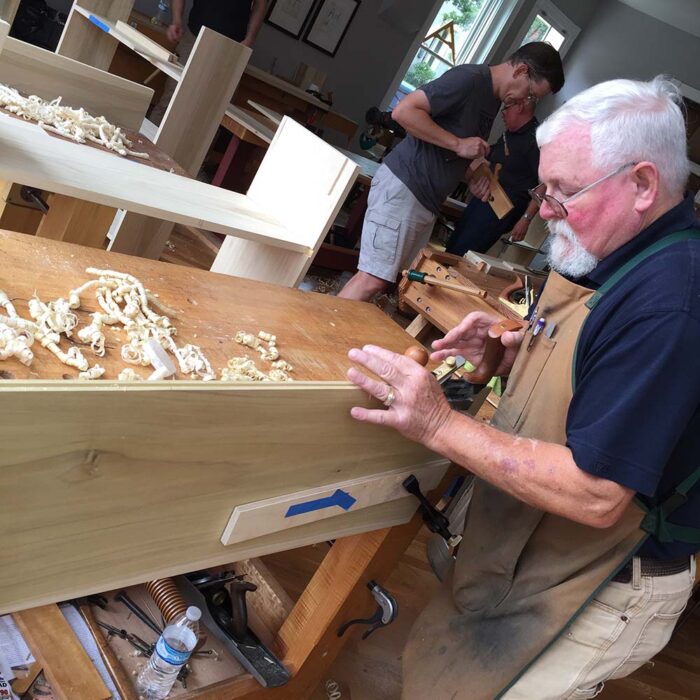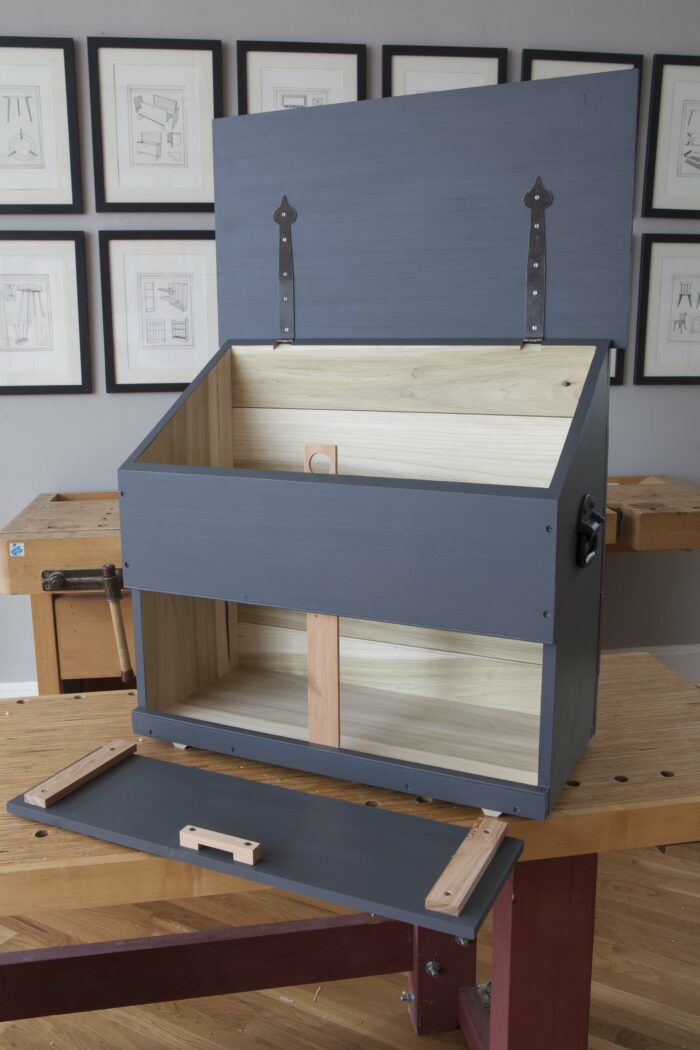Skills class or project class?
Even though learning new skills is the meat of a beginner class, Megan Fitzpatrick finds it's the project that makes it appetizing.
A recent woodworking forum thread involved a debate as to whether a “skills” class or a “project” class is the better way to get started in hand-tool woodworking. It is my contention that most hand-tool classes – whether you’re building a project or not – are skills classes that by (almost) any other name would smell more sweet. (And may I just say how happy I am that there are once again in-person classes about which to debate!)
No matter how “kitted out” a project, the student still has to put it together, and that is going to involve some form of joinery, even if it’s a simple nailed construction. Because yes, how you hold the hammer matters (more power if you grip near the end; grip with your fist, thumb extended in the direction you’re striking) , and it takes practice to not “French” the board (I assume the French say “sacré bleu – je suis Englished la planche“). And if you’re using cut nails, there’s also proper drilling to learn (“dovetailing” the nails – slightly angling them – increases the joint strength – also true for round-shanked nails…but I wouldn’t use those for furniture).
And even for a nailed-together hand-tool project, odds are good that you’ll also learn how to at least smooth-plane it. And that’s a skill that doesn’t come easily, especially when you include how to sharpen and set up this most finicky of planes, and it’s a skill that can be used on just about every future project.
The North Bennet Street School Toolbox with Matt Wajda
For the instructors at the school, this toolbox is an important teaching
tool that covers an array of hand-tool and machine techniques.
Take the English tool chest, for example. Every woodworker needs tool storage, and a large chest (that could also be used as a blanket chest or toy chest) looks fairly impressive. So I think the project is what sells it. If I called it “Four Days of Dovetails & One Day of Other Stuff,” well, I’m not sure the response would be as good. But it really is four days of dovetails with a bit of planing for the carcase parts, and some drilling and nailing for the bottom boards. Then one day of constructing the lid. It sounds pretty boring when put like that. At the end, you take home a nice (one hopes!) chest, and you’ll probably be pretty good at dovetails, or at least a lot better than you were five days past.

Almost every beginner class I’ve taught is billed as a “project” class, because I think that for those just getting started, producing a project is usually key to getting hooked on woodworking. If you don’t already know that you like the craft, cutting dovetails for two (or four) days with nothing to show for it might not intrigue you enough to try again. And it is even less likely to convince anyone with whom you share a savings account and/or bed that it’s worth the time, effort, and cost. Bring home a nice piece that you’ve made with your own two hands, though, and every time you see it, you’ll feel proud of what you’ve accomplished, be motivated to do even better next time, or both. (And you can then say to your SO, “heck – I can build that for less!” which is an excellent excuse to “need” to buy a new tool or two. Just be sure to follow through.)
My task as an instructor is to come up with a project that people not only want to build, but that teaches a lot of skills. Then it’s to make sure people have fun – safely – while learning, so they want to do it again. And to do my best to make sure every student leaves with a project that is, if not completely finished, finished enough that it can be easily completed at home with the tools and skills – some of them newly learned – in that person’s kit. I’m sure I’m not alone in that.

So if you are that rare beginner who wants to learn hand-tool skills independent of a project, I suggest you look beyond the class title; odds are decent that the class description will at least mention, if not list, the skills you’ll learn. And even if you don’t need a tool chest/Shaker table/step stool/etc., I’ll bet you know someone who will be delighted to receive your project as a gift. The challenge then becomes, 15 years on, to get it back and give them something better… then burn your early work. (This might be a personal problem.)
Carving Class with The Master, Dimitrios Klitsas
Handwork: Build a saw bench
Tongue-and-Groove Joints by Hand



















Comments
Great article.
Classes are (mostly) for beginners. Beginners need a toolbox. I want go to a class to build a reproduction of your grandfather’s toolbox (or mine, they are very similar). It is smaller than the Dutch or English toolboxes and is more portable for old people.
I would be delighted to take one of your courses. Though you don't say so exactly it's obvious you bring a student-centered mind set to your sessions. Here's a few more thoughts from a fellow traveler about that.
I was lucky to spend 16 years running a hand tool woodworking program for my school district. My classrooms were 96 passenger school buses I custom fitted out with workbenches and a collection common tools and materials--wood and common hardware items. In that time I had several thousand students build projects who ranged in age from as young as 3 years old to teachers in graduate degree programs. Regardless of their ages or initial skill levels I always thought of the work my students did as falling on an "autonomy continuum" and my objective was always to help them become more autonomous in their work.
For total neophytes the left end of that continuum would be "cookie cutter" projects--ones that exactly copied models I had developed that involved basic tool skills. More advanced students--while consulting with me--might take some cookie cutter project or combine elements of several to come up with something more challenging, satisfying and personally interesting. These projects gave the builders greater autonomy and independence to exercise prior skills and knowledge in their work. At the far right end of the continuum was the realm of pure "design then build" and virtually unfettered autonomy...to succeed or fail. The only limits of what my students might do in that range were the time they had available with me in the shop and the materials and other supplies they might need. For these students I functioned primarily as a mentor/consultant...as well as safety supervisor. Each student had a materials/supplies allowance which provided an effective constraint on possible designs. We all had to stay safe and within our budgets!
Your classes/projects are clearly developed to teach particular skills within a set of constraints (time, materials available, tools available, etc.). Beyond those considerations isn't it all about motivation? What I found most helpful in keeping my students motivated was the degree to which I could recognize where they might fall on my autonomy continuum and then let them work from there. I certainly always left room for creativity in interpreting cookie cutter projects if a student was inspired to customize. There are always times when we have to go back to the cookie cutter stage to practice some brand new skill or technique or become familiar with a new tool but in my experience every project can be nudged to maximize autonomy.
Keep up the inspiring teaching. I've been enjoying your pieces in FWW.
Log in or create an account to post a comment.
Sign up Log in